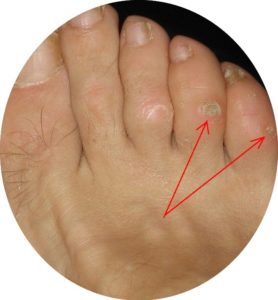
What Are Corns?
Corns on foot are formed by layers of dead skin which develop as a response to pressure and friction. They are your body’s way to protect itself from the foot pain and injury that can be caused by intense, prolonged pressure that affects a specific spot in your skin. The symptoms of a corn on your foot can include:
- A thick, hardened patch of skin. The skin on this area is usually dry, and flaky; it can also be yellowed. A corn on foot skin tends to be small and circular in shape.
- A corn on the foot can be painful when pressed, unlike other types of calluses.
- The skin around the corn tends to be soft and swollen, but the center of the corn is usually hardened and indurated.
- Calluses usually develop on non-weight bearing surfaces, but they can also occur on places such as your knees, and on the balls of your feet.
How Do You Get Them?
Corns develop as a result of friction caused by prolonged pressure or repetitive movements. The source of this friction can be:
- Wearing ill-fitting shoes: there are many ways in which your footwear can cause a corn on your foot. Shoes that are too loose can cause your feet to slide around in them, and poorly-made shoes can have seams that can rub against your skin. Tight shoes, especially those with narrow toe boxes, can also create pressure against the side of your foot.
- Foot abnormalities: physical deformities, such as hammertoes, or defects in the biomechanics of your gait and movements can put you at higher risk of developing foot corns. These factors should be assessed by your podiatrist.
- Risk factors include not wearing socks, performing repetitive actions such as jogging, and old age, since fatty tissue tends to decrease in seniors.
How Do You Treat Them?
Fortunately, corns on foot skin are easy to treat. Home treatments for foot corns include soaking your foot in warm water and then rubbing the corn with a pumice stone. You can find corn pads that contain salicylic acid at the drugstore. The acid will help soften and remove the corn. You should also make sure to keep your skin hydrated and clean.
If the corn on your foot becomes too painful, or if you suffer from diabetes or any other disease that affects your circulation, your Podiatrist Sydney will be able to provide different therapeutic options for this condition.
